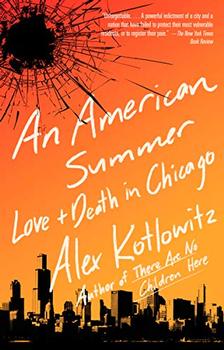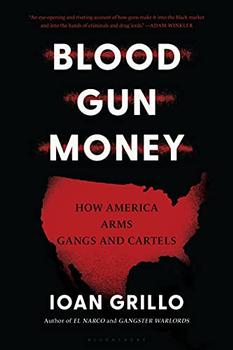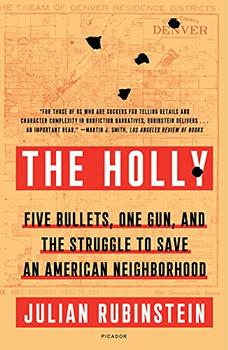Summary | Excerpt | Reviews | Beyond the book | Read-Alikes | Genres & Themes | Author Bio

Love and Death in Chicago
by Alex KotlowitzAs a Chicagoan, I've become used to the most common reactions when I'm traveling and tell someone where I'm from. Most of us are accustomed to it—the questions about "what it's like" here, and the unspoken assessment of a place seemingly steeped in violence, whether the historical kind of Al Capone and Prohibition-era gangsters, or the rampant gun violence people hear about today in the news.
What we residents can rarely explain in those moments is the complicated backstory. In An American Summer: Love and Death in Chicago, Alex Kotlowitz patiently takes the reader through the streets, neighborhoods and institutions that are both the cause and the result of ongoing violence. More importantly, he humanizes the problem through personal stories and deep immersion in the lives of real people who have been affected.
Kotlowitz is as much an ethnographer as he is an author; in 1991 he published There Are No Children Here, a close-up account of life in Chicago's housing projects. Thus An American Summer comes from a place of deep knowledge about the city. In it, he documents the summer of 2013 through the experiences of a range of people, all of whom are personally impacted by violence in one way or another.
He introduces us to mothers like Lisa Daniels, whose son was killed in a drug-deal-turned-robbery. Daniels forgave her son's killer and encouraged him to make positive changes while he was in prison. Kotlowitz takes the reader inside the lives of young people forever changed by violence, sometimes through their participation in it, such as Marcelo, a teenager given a second chance through a halfway house, who struggles with the legal and emotional repercussions of his role in a robbery and shooting.
We meet Thomas, a high school student who witnessed multiple close friends and relatives get shot, including an 11-year-old girl celebrating her birthday inside her home. Withdrawn and emotionally scarred by his experiences, Thomas and the few social workers at his school try to rebuild his life, but more often than not settle for just making it through each day.
An American Summer even recounts the experiences of ostensible outsiders, like Chicago Tribune reporter Peter Nickeus, whose job covering police activity and shootings across the city leads to adverse changes in both his physical and mental health, including weight gain from stress and self-isolation. What readers see is how pervasive the damage is—how violence affects everyone touched by it and for many years after it happens.
By revealing the people behind the numbers, Kotlowitz effectively contradicts numerous stereotypes and assumptions about violence in Chicago, and the Black and Hispanic communities disproportionately impacted by it. There is a persistent misconception that most shootings are gang-related, and thus most victims are somehow complicit. It's a method of rationalizing a terrible death toll in a major American city, and it absolves policymakers or those in power of responsibility for the conditions that engender such violence. But it isn't true. As Kotlowitz shows, sudden bad decisions or minor transgressions can spiral into lethal consequences, but they are not always tied to gang reprisals. All too often they're the result of individual mistakes.
"Should this singular moment constrict the rest of his life?" Kotlowitz asks of Marcelo, facing a possible felony conviction. Another father tells a reporter that his murdered son wasn't involved in any gang activity "in an effort to offset what he knows everyone's thinking: Your son did something to deserve this." These stories force the reader to examine their own latent biases and ways of explaining away the horror of so much death in the heartland of America.
Kotlowitz also illuminates some realities too often obscured in the search for quick fixes about how to stop the violence. For example, through the death of Ramaine Hill he explains the likelihood of a person being murdered when they work with the police or testify against another shooter. Kotlowitz shows it's not that Black or Hispanic residents don't care about justice, but that acting as a witness carries deadly reprisals, which the police then can't or won't address. Furthermore, the police themselves can be the source of violence; Kotlowitz spends a chapter describing the murder of Calvin Cross by the police, who planted a gun and lied about their motivation for shooting him.
Providing needed context, Kotlowitz addresses the racist housing policies that forced non-white residents into dangerously neglected housing projects and the discriminatory policing that destroys trust between citizens and those sworn to protect them. He describes the former projects and the flawed plan for their demolition, and he nods to the wave of school closings that further demoralized predominantly Black and Hispanic communities (see Beyond the Book).
These stories are valuable, but they come too late in the book and are dealt with too delicately. The decades of discriminatory housing policies and sanctioned violence to enforce them are not discussed; lack of investment in economically struggling neighborhoods is barely addressed; and the racism in the Chicago Police Department that led to a police captain being jailed for systematic torture of Black men and millions of dollars in wrongful conviction lawsuits did not garner a mention. It's understandable that Kotlowitz wants to maintain some sense of objectivity about the violence, but the narrative is incomplete without at least an acknowledgment of the varied systemic factors that influence it.
Kotlowitz is more adept in showing the inadequacy of current political solutions to the pervasive violence. A mentally disabled teenager is jailed for decades due to minimum sentencing laws, and the judge's passionate excoriation of being forced to hand down a sentence he disagreed with shows the absurdity of such laws in practice. The proposal by then-senator Mark Kirk to arrest 18,000 gang members is dismantled as folly, as Kotlowitz tags along while Congressman Bobby Rush takes Kirk through the Englewood neighborhood to see the isolation and economic stagnation in person.
These discussions are vital to counteract assumptions that if there were just better policing and better cooperation, the violence would stop. It's important to begin the longer, more difficult conversations around the causes and effects of the violence, even if this book misses an opportunity to delve further into the roots of it.
And meanwhile, the violence continues. In the nearly six years since Kotlowitz chronicled these stories, there have been no meaningful policy changes, no shifts in police relations, and no abatement to the violence that damages real people, whether their names and stories are recorded in a book or not.
![]() This review
first ran in the April 17, 2019
issue of BookBrowse Recommends.
This review
first ran in the April 17, 2019
issue of BookBrowse Recommends.

If you liked An American Summer, try these:

by Ioan Grillo
Published 2023
The gun control debate is revived with every mass shooting. But far more people die from gun deaths on the street corners of inner city America and across the border as Mexico's powerful cartels battle to control the drug trade.

by Julian Rubinstein
Published 2022
An award-winning journalist's dramatic account of a shooting that shook a community to its core, with important implications for the future
When a true genius appears in the world, you may know him by this sign...
Click Here to find out who said this, as well as discovering other famous literary quotes!
Your guide toexceptional books
BookBrowse seeks out and recommends the best in contemporary fiction and nonfiction—books that not only engage and entertain but also deepen our understanding of ourselves and the world around us.